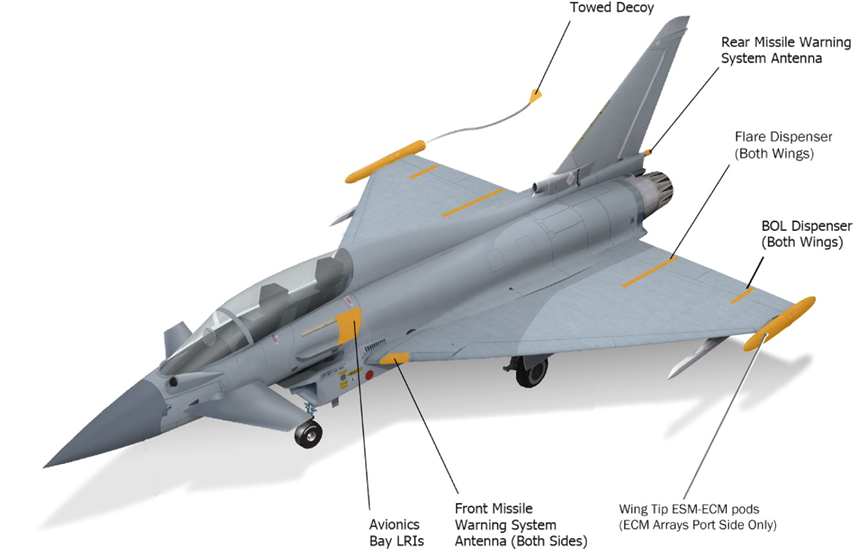The Eurofighter Typhoon is the world’s most powerful and reliable swing-role combat aircraft, built on the strength of four European nations – UK, Germany, Italy and Spain, and their leading aerospace and defence companies. The only fighter available on the market able to offer such wide-ranging operational capabilities, Typhoon combines airframe performance, an advanced human-machine-interface, powerful engines and ground-breaking sensing and defensive technologies to give pilots the edge in today’s competitive digital battlefield.
The EuroDASS consortium, led by Leonardo in the UK and incorporating Elettronica (Italy), Hensoldt (Germany) and Indra (Spain), provides the Praetorian Defensive Aids Sub System (DASS) for Typhoon, ensuring protection from a wide range of advanced threats. As an integrated system, Praetorian greatly enhances Typhoon’s survivability, allowing freedom of action even in complex, congested and contested theatres. The system has protected crews for over 20 years, including peace-keeping operations in Libya and Syria.

Praetorian DASS comprises a comprehensive suite of Electronic Support Measures (ESM), Electronic Counter Measures (ECM) and Missile Approach Warning (MAW). It provides protection against air-to-air and surface-to-air threats by monitoring and proactively responding to the operational environment, detecting and evaluating threats and initiating appropriate countermeasures at maximum range. Praetorian integrates with the remaining elements of the Typhoon Defensive Aids System (DAS), namely the Defensive Aids Computer (DAC) and the Chaff and Flare Counter-Measures Dispensing System (CMDS), to ensure end-to-end protection.
Electronic Support Measures (ESM)
The ESM is designed to detect threat radars using super-heterodyne and digital receivers. The ESM antennas are located in wing tip pods giving unprecedented full spherical spatial coverage. The receiver can detect and identify over a broad range of frequencies, sufficient to detect nearly all types of radar systems and even to detect other RF sources such as radios or datalink systems. The data is compared with the database of radar signatures stored in the Electronic Support Measures suite. Using this information the ESM allows the identification of the radar and thus the platform it is deployed from and presents it on a moving map or multifunction display producing a 360° threat picture around the aircraft including identifying targets and even their zones of lethality. This allows the pilot to fly around these zones to avoid detection or being engaged. Thus the system not only warns a pilot but it helps situational awareness of potential targets.
Electronic Counter Measures (ECM)
The ECM wingtip pod features an internal electronic countermeasures system (ECM) that uses digital radio frequency memory (DRFM) and digital frequency techniques generator to jam multiple airborne and ground-based radar systems at the same time and at long ranges. One antenna is located in front of the left wing tip pod, and another at the rear end.
In addition to the on-board ECM, another active countermeasure is the Towed Radar Decoy (TRD). This is carried in the rear of starboard wingtip pod, and deployed from the pod on a tow cable containing a Fibre Optic link and a separate power line. The TRDs are effective against a variety of different radar systems like monopulse, Track While Scan (TWS) or CLOS (Command Line Of Sight) radars. As the TRD is an off board jammer, radar systems featuring a home on jam (HOJ) mode will not be able to directly lock on to the aircraft itself. The effectiveness is further enhanced by the release of Chaff clouds making the decoy a more attractive target for the missile. The TRD can tolerate speeds of up to Mach 2 and loads of + 9 / -3g
Missile Approach Warning (MAW)
To track missiles launched at the Typhoon, the DASS incorporates a Missile Approach Warning (MAW) with antennas in the wing roots and one in the tail to provide coverage around the aircraft. The missile approach warner utilises a pulse-doppler radar for detection and is able to detect not only radar guided ordnance but also passive weapons such as infra-red guided short range missiles. They can detect multiple missiles launched towards the aircraft in all weather conditions and even after the rocket motor’s burnout phase. Once a missile is detected it will be identified according to whether radar or IR guided and its location displayed on the MFDs. The MAW can automatically activate the chaff/flare dispensers as required.
Integrated Mission Data management
The DASS is supported by a comprehensive Integrated Mission Data management suite. This allows for National Mission Data to be created, updated and verified in an agile manner. A suite of tools supports the Mission Data, scalable to individual nations requirements and needs. In the modern digital battlespace, the agility to react and change to operational demands is a discriminator, one which is fully supported by the Integrated Mission Data management at the heart of the DASS.
The capability of the DASS is ever evolving via the DASS Package programme. This is a regular update programme, aligned to nations’ ongoing trials and expectations, which continually develops the operational capability of the DASS predominately by software update, providing a responsive and agile enhancement programme addressing the future needs of nations.





